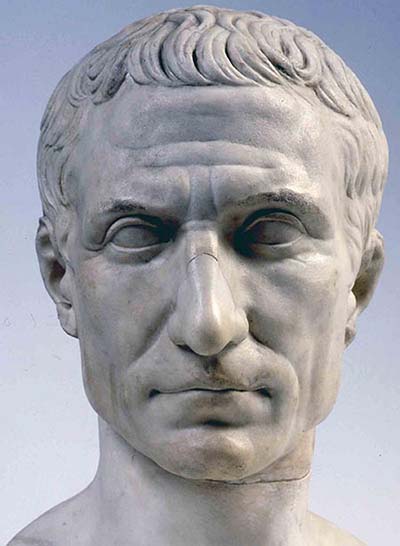The battle of Tapso was a military clash, occurred on 7 February of 46 ac (according to the Gregorian calendar), between the legions led by Gaius Julius Caesar and the remaining forces available to the Roman Republic, after the defeat at Farsalo and the killing of Pompey.
Tapso is counted among the tactical and strategic masterpieces of Caesar, since his men completely defeated the opponents, thus paving the way to his commander, who, thanks to this victory, strengthened his political position by approaching to obtain an absolute power. The subsequent escape of the Republicans in Iberia will lead to the clash of Munda, where they were completely annihilated and where Cesare obtained the total triumph.
Caesar, who had landed in Africa, started a series of skirmishes with the rival party, to then proceed and lay siege to the town of Tapso. First the dictator he blocked southern access to the city by erecting three fortified lines. This was a strong point of his tactics: he had used the fortifications also in Alesia against the roosters, in Brindisi, during the siege of Alexandria in Egypt and finally against the monarch of Pontus Farnace II in Zela.
Metellus Scipio, commander-in-chief of the republican troops, attempted to cut off any way out of the Caesarean by dividing his forces (also reinforced by the troops of the Numidian king Juba) and attesting them to the isthmus, where the legions of Caesar were placed. 'further step that connected the city to the mainland, located north-west from the Caesar position.
 Il dictator he was completely encircled: every possibility of retiring had been precluded. If he tried to break on one side he would have been vulnerable to his hips, thus risking being defeated. A truly thorny situation.
Il dictator he was completely encircled: every possibility of retiring had been precluded. If he tried to break on one side he would have been vulnerable to his hips, thus risking being defeated. A truly thorny situation.
The latter became even more serious for the conqueror of the Gauls because of its numerical inferiority: according to different sources (the most reliable are Plutarch and the Cesararian Commentaries), Caesar had about 10 legions; Scipione, however, had under his command at least 40.000 men (or a dozen legions), auxilia units, which were composed of elephants, several units of cavalry (according to some estimates 2500), and finally the soldiers of Juba Numbers . Despite the unfavorable position and the numerical disparity with the opponents, Cesare kept an ace up his sleeve: the Tapso's swampy ground. In fact, Scipione and Giuba had encircled Caesar, caging him within the two instincts, but at the same time this move was revealed to them as a double-edged sword, since they were forced to place their line on a swampy ground and restricted. The tactical advantage to Caesar was that the terrain reduced the impact force of cavalry and elephants, as well as of light infantry.
The Caesarians then descended into battle and established themselves by adopting the privileged tactic of their commander: the infantry in the center, in order to sustain the enemy collision, the cavalry, the archers and the slingers at the sides. Behind the formation was placed the 5th Legion, specially trained to fight the elephants. The winner of Farsalo and Alesia was positioned on the right side, as usual. According to Plutarch, Caesar had one of his epileptic attacks, which prevented him from commanding and fighting during the clash.
Scipione, on the other hand, sided the elephants in front of the adversary legionaries, and also adopted the classic Roman scheme: cavalry on the flanks and infantrymen in the center.
According to the chronicles, the battle began not with a direct order of Caesar but by the will of the tenth Legion, who launched the assault despite the constant recalls to the order of their officers. Caesar gave the order to attack after the initiative taken by the Tenth.

The first immediate danger for the Caesar legionaries was the elephants, who were promptly rejected thanks to the intervention of the Thursday, which succeeded, through various stratagems, such as throwing rocks and making a loud noise, scaring the pachyderms and then making sure that they ran away. In their flight they swept the ranks of the republicans, who, along with the numbers, ended up en route. Caesar had also won this time, but the battle was not over.
Despite the flight of enemies, the Caesar soldiers, tired of the long civil war and the campaigns led by the dictator previously, they did not obey their master's direct orders to stop, and so they continued their pursuit: it was a massacre, an inaudible bloodbath. According to reports of the time, Scipio's soldiers suffered about 10.000 losses, while among the legionaries of Caesar died about 50 men. Not even those who presented the surrender were spared. No prisoner.
The survivors did not have an easy life: many of their commanders, including Scipione and Cato the Uticense, committed suicide in the aftermath of the battle. Others, like Tito Labieno and the sons of Gnaeus Pompey the Great, organized one last desperate resistance in Spain with the veterans of the disastrous "Africa Campaign".
Within a few weeks, the whole of North Africa fell into the hands of the Dictator, which will turn its attention to the last irreducible, triumphing.
(opening image: Michele Marsan)












